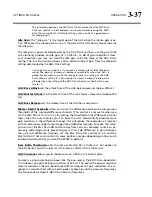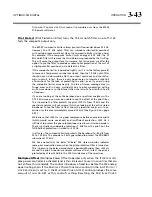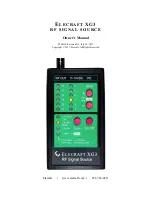
3-44
OPERATION
ORBAN MODEL 8500S
T
HRESHOLD
control away from
0
will change the loss. (For example, setting the
M
ULTIPLEX
P
OWER
T
HRESHOLD
control to
+3
will cause the loss to decrease by 3 dB.)
The
M
ULTIPLEX
P
OWER
T
HRESHOLD
control can only introduce loss, never
gain.
Regardless of the setting of the
M
ULTIPLEX
P
OWER
T
HRESHOLD
and
M
ULTIPLEX
P
OWER
O
FFSET
controls, the resulting gain offset can never be
larger than 0 dB.
The
M
ULTIPLEX
P
OWER
O
FFSET
control’s purpose is to reduce unnatural loudness varia-
tions that the multiplex power controller might produce. These can occur because
the ITU specification does not call for psychoacoustic weighting. The Optimod does
not force the multiplex power controller to dynamically produce all of the required
gain reduction (which could vary widely, depending on the program material). In-
stead, the
M
ULTIPLEX
P
OWER
O
FFSET
control produces most of the gain reduction. The
gain reduction produced by the control is, of course, unchanging and cannot intro-
duce audible artifacts.
The ideal dynamic gain reduction for the multiplex power controller is 2 to 3 dB
with typical program material. However, the actual gain reduction will vary widely
depending on whether the underlying processing preset is “loud” or “quiet.” There-
fore, the appropriate setting of the
M
ULTIPLEX
P
OWER
O
FFSET
control depends
strongly on what preset is in use. Accordingly, each preset has its own setting of the
M
ULTIPLEX
P
OWER
O
FFSET
, which is a processing parameter like any other in a given
preset. Hence, adjustments that affect the multiplex power controller appear in two
independent places in the Optimod: The
M
ULTIPLEX
P
OWER
T
HRESHOLD
control is a
sys-
tem setup
control, while the
M
ULTIPLEX
P
OWER
O
FFSET
is
part of the on-air preset
.
Depending on the preset, the
M
ULTIPLEX
P
OWER
O
FFSET
control’s setting can vary
from 0 dB (no effect) to as much as –16 dB. If you customize a preset in any way (in-
cluding using
L
ESS
-M
ORE
)
, you may wish to trim the
M
ULTIPLEX
P
OWER
O
FFSET
for
that preset so that the multiplex power controller produces 2-3 dB of indicated gain
reduction with typical program material. This will achieve the maximum on-air loud-
ness that complies with the ITU standard while minimizing the potential for unnatu-
ral and audibly disturbing loudness inconsistencies caused by the operation of the
multiplex power controller.
For more information on the multiplex power controller, refer to
on page 3-72.
The Two-Band Structure
The Two-Band structure consists of a slow two-band gated AGC (Automatic Gain
Control) for gain riding, followed by an equalization section, a gated two-band
compressor, a high-frequency limiter, and a complex peak limiting system similar to
the one used in the Five-Band structure. Like the “Two-Band Purist” structure in
Orban’s OPTIMOD-FM 8200, the 8500S’s Two-Band Structure is phase-linear through-
out to maximize sonic transparency.
The Two-Band structure has an open, easy-to-listen-to sound that is similar to the
source material if the source material is of good quality. However, if the spectral bal-
Summary of Contents for OPTIMOD-FM 8500S
Page 1: ...Operating Manual OPTIMOD FM 8500S Digital Audio Processor Version 1 0 Software...
Page 7: ...Operating Manual OPTIMOD FM 8500S Digital Audio Processor Version 1 0 Software...
Page 26: ......
Page 56: ......
Page 164: ......
Page 308: ......
Page 310: ...6 28 TECHNICAL DATA ORBAN MODEL 8500S CONTROL BOARD PARTS LOCATOR...
















































